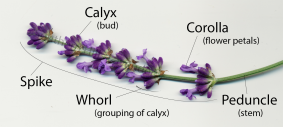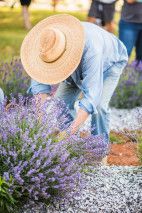What is Lavender?
Lavender is a perennial herb plant and it produces long stems with buds and blooms. It has a wonderful and aromatic smell. If you’ve never smelled fresh lavender before, it’s an experience that everyone should have! The leaves can be silvery grey to bright green and the blooms can be deep purple to blue-purple, pink, and even white. The plant is a mounded bush format and can be 1-3 feet across (there are some large varieties that can get larger than that!). The buds and stems can be used as they are in decorations or crafts or they can be used to produce essential oil which is used by itself and in countless value-added products. There are hundreds of varieties of lavender with different colors, sizes, and slightly different smells.
(click the image for a larger version)
Lavender dates back to Roman times and when most people hear “lavender” they think of France and Grandmas. We love our Grandmas (and Memas and Nanas)! But lavender has a wider reach today and is being used in the U.S. for everything from a agri-tourism farm, festivals, products, group outings, teas and lunches, weddings, pet products, decorations, life aids, art, and natural lifestyles. Whether you want a candle with real lavender smell, something to help you sleep better, or something new to taste, lavender has many modern purposes. As we like to say, it’s the duct tape of the herbal world!
Lavender is generally known and loved for its’ smell, sleep and relaxation support, healing aid, cleaning properties and as a culinary star. Lavender got its’ modern medicinal start in 1910 when it helped heal a burn of French chemist and scholar René-Maurice Gattefossé. Read the story here.
While there are not a lot of clinical studies on lavender and we can not make medical claims, here are some overviews and information:
- NIH/NCCIH – Lavender Overview
- NIH/NCCIH – Lavender and the Nervous System
- University of Maryland Medical Center – Lavender Overview
- Tisserand – Lavender is not estrogenic
- Abstracts:
- PubMed – The effectiveness of aromatherapy massage using lavender oil as a treatment for infantile colic.
- PubMed – The effect of lavender aromatherapy on cognitive function, emotion, and aggressive behavior of elderly with dementia
- PubMed – The effects of lavender oil inhalation on emotional states, autonomic nervous system, and brain electrical activity
- PubMed – The antimicrobial activity of high-necrodane and other lavender oils on methicillin-sensitive and -resistant Staphylococcus aureus (MSSA and MRSA)
- PubMed – Lavender. Dermatitis.
- PubMed – Lavandula angustifolia Mill. Oil and Its Active Constituent Linalyl Acetate Alleviate Pain and Urinary Residual Sense after Colorectal Cancer Surgery: A Randomised Controlled Trial.
- PubMed – Relaxation effects of lavender aromatherapy improve coronary flow velocity reserve in healthy men evaluated by transthoracic Doppler echocardiography
- Biosynthesis and therapeutic properties of Lavandula essential oil constituents
Lavender’s scientific name is Lavandula and it’s part of the mint family, Lamiaceae (look for the square stems!). Lavandula is a large group with 39 species and 100s of cultivars. There is a wide variety of shapes, colors, and smells across the species. The main types we see today are L. angustifolia, x. intermedia, and Stoechas and Dentata.
- Angustifolia are generally smaller plants and have a “sweeter” smell and taste. Some Angustifolia varieties are: Hidcote, Munstead, Betty’s Blue, Royal Velvet, Folgate, Mailette, Buena Vista, and Melissa.
- Intermedia are a hybrid of Angustifolia and another species, Latifolia. Intermedias are generally larger plants, the stems are longer, and they have a more camphor taste and smell. Some examples of this variety are: Grosso, Provence, Impress Purple, Fred Boutin, and Phenomenal.
- Stoechas is the variety with wings or bunny ears. It has a different smell and is not hardy. It should be grown in pots where they can be brought in during the winter.
- Dentata have leaves with toothed edges. It is not hardy and should be grown in pots where they can be brought in during the winter.

